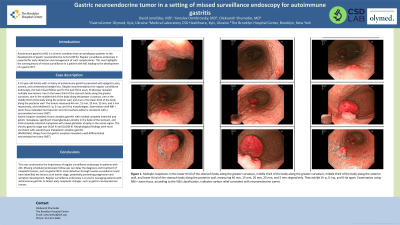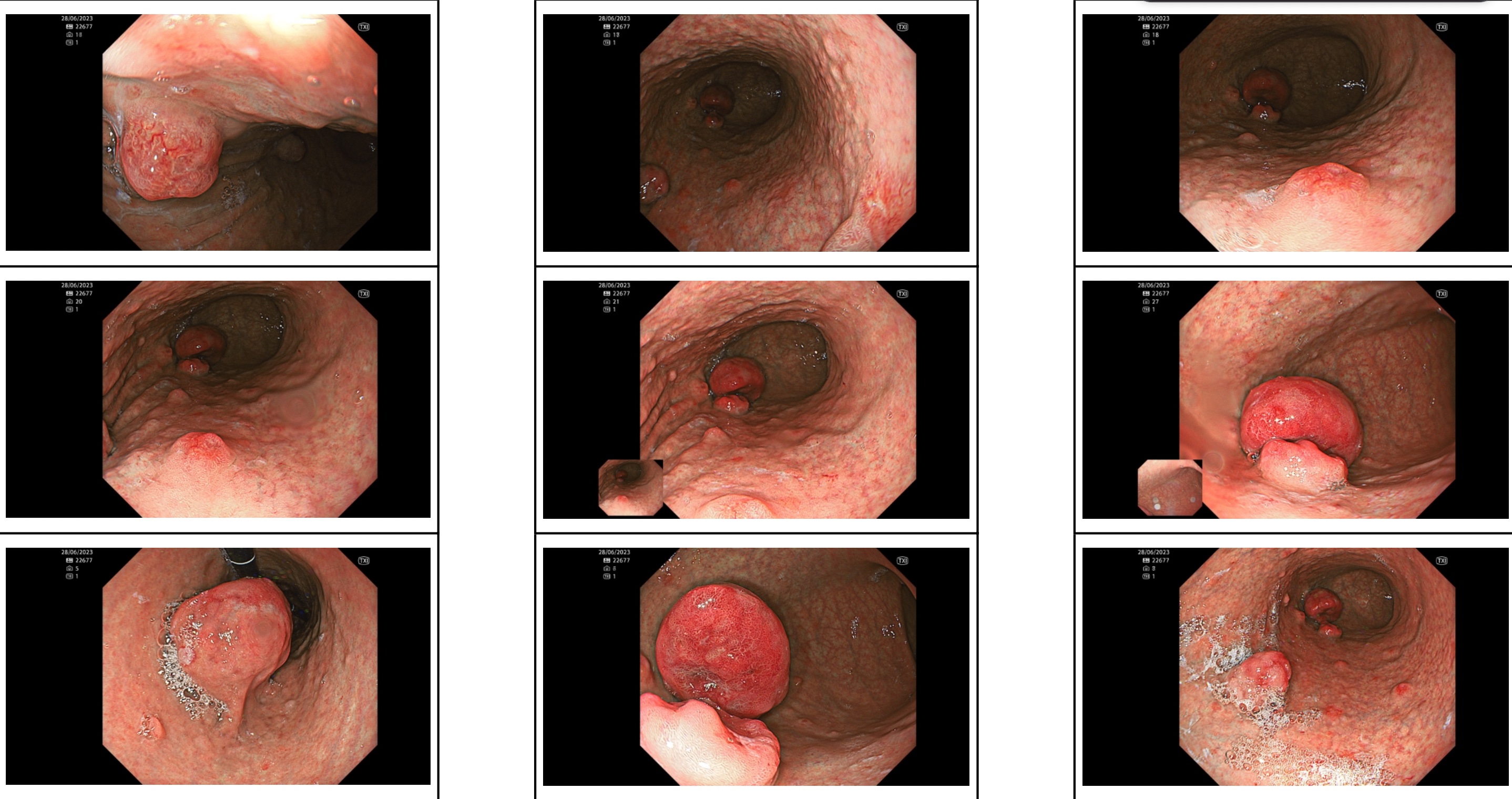Sunday Poster Session
Category: Stomach
P1709 - Gastric Neuroendocrine Tumor in a Setting of Missed Surveillance Endoscopy for Autoimmune Gastritis
Sunday, October 27, 2024
3:30 PM - 7:00 PM ET
Location: Exhibit Hall E

Has Audio

Oleksandr Shumeiko, MD
Brooklyn Hospital Center
Brooklyn, NY
Presenting Author(s)
David Janelidze, MD, PhD1, Yaroslav Dombrovsky, MD2, Oleksandr Shumeiko, MD3
1GastroCenter Olymed, Kyiv, Kyyiv, Ukraine; 2Medical Laboratory CSD Health Care, Kyiv, Kyyiv, Ukraine; 3Brooklyn Hospital Center, Brooklyn, NY
Introduction: Autoimmune gastritis (AIG) is a chronic condition that can predispose patients to the development of gastric neuroendocrine tumors (NETs). Regular surveillance endoscopy is essential for early detection and management of such complications. This case highlights the consequences of missed surveillance in a patient with AIG leading to the development of a gastric NET.
Case Description/Methods: A 52-year-old female with a history of autoimmune gastritis presented with epigastric pain, anemia, and unintentional weight loss. Despite recommendations for regular surveillance endoscopy, she had missed follow-ups for the past three years. Endoscopy revealed multiple new lesions: two in the lower third of the stomach body along the greater curvature, one in the middle third of the body along the greater curvature, one in the middle third of the body along the anterior wall, and one in the lower third of the body along the posterior wall. The lesions measured 40 mm, 15 mm, 20 mm, 25 mm, and 5 mm respectively, and exhibited 0-I p, 0-I sp, and 0-IIa morphologies. Examination with NBI + zoom focus indicated microvascular and microsurface patterns consistent with a neuroendocrine tumor (NET).
Gastric biopsies revealed chronic atrophic gastritis with marked complete intestinal and pyloric metaplasia, significant mixed glandular atrophy in the body of the stomach, and mild complete intestinal metaplasia with mixed glandular atrophy in the antral region. The chronic gastritis stage was OLGA III and OLGIM III. Morphological findings were most consistent with autoimmune metaplastic atrophic gastritis (AMAG/AIG). Biopsy from the gastric neoplasia revealed a well-differentiated neuroendocrine tumor (NET).
Discussion: This case underscores the importance of regular surveillance endoscopy in patients with AIG. Missing scheduled endoscopic follow-ups can delay the diagnosis and treatment of neoplastic lesions, such as gastric NETs. Early detection through routine surveillance could have identified the lesions at an earlier stage, potentially preventing progression and symptom development. Regular surveillance endoscopy is crucial in managing patients with autoimmune gastritis to detect early neoplastic changes, such as gastric neuroendocrine tumors.

Disclosures:
David Janelidze, MD, PhD1, Yaroslav Dombrovsky, MD2, Oleksandr Shumeiko, MD3. P1709 - Gastric Neuroendocrine Tumor in a Setting of Missed Surveillance Endoscopy for Autoimmune Gastritis, ACG 2024 Annual Scientific Meeting Abstracts. Philadelphia, PA: American College of Gastroenterology.
1GastroCenter Olymed, Kyiv, Kyyiv, Ukraine; 2Medical Laboratory CSD Health Care, Kyiv, Kyyiv, Ukraine; 3Brooklyn Hospital Center, Brooklyn, NY
Introduction: Autoimmune gastritis (AIG) is a chronic condition that can predispose patients to the development of gastric neuroendocrine tumors (NETs). Regular surveillance endoscopy is essential for early detection and management of such complications. This case highlights the consequences of missed surveillance in a patient with AIG leading to the development of a gastric NET.
Case Description/Methods: A 52-year-old female with a history of autoimmune gastritis presented with epigastric pain, anemia, and unintentional weight loss. Despite recommendations for regular surveillance endoscopy, she had missed follow-ups for the past three years. Endoscopy revealed multiple new lesions: two in the lower third of the stomach body along the greater curvature, one in the middle third of the body along the greater curvature, one in the middle third of the body along the anterior wall, and one in the lower third of the body along the posterior wall. The lesions measured 40 mm, 15 mm, 20 mm, 25 mm, and 5 mm respectively, and exhibited 0-I p, 0-I sp, and 0-IIa morphologies. Examination with NBI + zoom focus indicated microvascular and microsurface patterns consistent with a neuroendocrine tumor (NET).
Gastric biopsies revealed chronic atrophic gastritis with marked complete intestinal and pyloric metaplasia, significant mixed glandular atrophy in the body of the stomach, and mild complete intestinal metaplasia with mixed glandular atrophy in the antral region. The chronic gastritis stage was OLGA III and OLGIM III. Morphological findings were most consistent with autoimmune metaplastic atrophic gastritis (AMAG/AIG). Biopsy from the gastric neoplasia revealed a well-differentiated neuroendocrine tumor (NET).
Discussion: This case underscores the importance of regular surveillance endoscopy in patients with AIG. Missing scheduled endoscopic follow-ups can delay the diagnosis and treatment of neoplastic lesions, such as gastric NETs. Early detection through routine surveillance could have identified the lesions at an earlier stage, potentially preventing progression and symptom development. Regular surveillance endoscopy is crucial in managing patients with autoimmune gastritis to detect early neoplastic changes, such as gastric neuroendocrine tumors.

Figure: Multiple neoplasms in the lower third of the stomach body along the greater curvature, middle third of the body along the greater curvature, middle third of the body along the anterior wall, and lower third of the stomach body along the posterior wall, measuring 40 mm, 15 mm, 20 mm, 25 mm, and 5 mm respectively. They exhibit 0-I p, 0-I sp, and 0-IIa types. Examination using NBI + zoom focus, according to the V&S classification, indicates surface relief consistent with neuroendocrine tumor.
Disclosures:
David Janelidze indicated no relevant financial relationships.
Yaroslav Dombrovsky indicated no relevant financial relationships.
Oleksandr Shumeiko indicated no relevant financial relationships.
David Janelidze, MD, PhD1, Yaroslav Dombrovsky, MD2, Oleksandr Shumeiko, MD3. P1709 - Gastric Neuroendocrine Tumor in a Setting of Missed Surveillance Endoscopy for Autoimmune Gastritis, ACG 2024 Annual Scientific Meeting Abstracts. Philadelphia, PA: American College of Gastroenterology.
